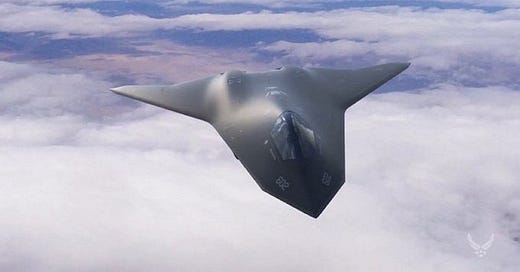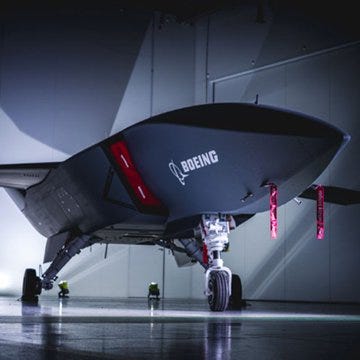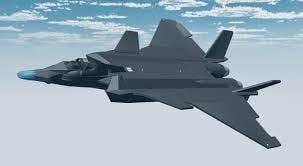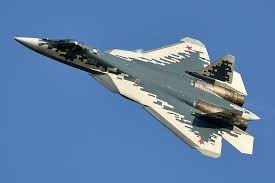President Trump announced that Boeing has been awarded a contract by the U.S. Air Force to build the F-47, the world’s first sixth-generation fighter jet, as part of the Next Generation Air Dominance (NGAD) program. Boeing won this contract over Lockheed Martin.
PRESIDENT TRUMP: "The F-47 will be the most advanced, most capable, most lethal aircraft ever built. An experimental version of the plane has secretly been flying for almost 5 years and we're confident that it massively overpowers the capabilities of any other nation. This was a big secret. In fact, we don’t show too much of the plane for that reason."
SECRETARY OF DEFENSE HEGSETH: “The name of this program is ‘The Next Generation of Air Dominance.’ The Next Generation of Air Dominance sends a very direct and clear message to our allies and our enemies that we are not going anywhere!”
Officials claim it surpasses every other aircraft on Earth. It has been nicknamed the “Ghost Eagle” by some in the MIC.
Boeing has kept the details under wraps, but experts say it leapfrogs the F-22 and F-35 by a full generation — and positions America for total dominance in future air combat.
[Remember that I said I thought that the recent failures of existing planes could be a sabotage campaign among competitors for contracts? Well, I think I was probably right.]
This aircraft is intended to replace the F-22 Raptor, the U.S.’s first fifth-generation fighter, which entered service in 2005. An experimental version has been secretly flying for nearly five years - since 2020 in the LAST Trump administration.
The F47 "Ghost Eagle" has been a secretive development process and part of the U.S. Air Force's Next Generation Air Dominance (NGAD) program. As a six-generation aircraft, it replaces the F-22 Raptor and surpasses China's J-20 in AI, stealth, and hypersonic weapon capabilities.
The F-47 is described as a "family of systems," meaning it will integrate with un-crewed Collaborative Combat Aircraft (CCA)—drones acting as "loyal wingmen"—to enhance its operational effectiveness. This aligns with modern warfare trends, where manned aircraft work alongside un-manned systems to project power in contested environments. The jet is expected to feature cutting-edge stealth technology, advanced sensors, and next-generation propulsion system.
The F-47’s advanced capabilities—stealth, speed, and adaptability—are designed to ensure U.S. air dominance, particularly against capable adversaries like China and Russia.
Awarding the contract to Boeing, a U.S. company, supports domestic industry and jobs, particularly in St. Louis, Missouri, where fighter jet production is based. Boeing’s win over Lockheed Martin also revitalizes its defense sector, which has faced challenges with cost overruns on other programs.
Unlike the F-22, which was limited in production and cannot be sold to allies due to congressional restrictions, the F-47 is designed to be more sustainable, cost-effective, and adaptable.
Trump’s statement that an experimental version has been flying for "almost five years" confirms that development began around mid-2020 when he was still in office for his first term. This aligns with a September 2020 announcement by then-Assistant Secretary of the Air Force Will Roper, who revealed that an NGAD demonstrator had already flown. Since then, reports indicate at least three NGAD-related prototypes (X-planes) have been tested, accumulating hundreds of flight hours to refine technologies like stealth, propulsion, and digital engineering.
The Air Force aims to field the F-47 in the 2030s, with initial operational capability possibly during Trump’s second term (ending January 2029.) This timeline reflects a rapid yet deliberate process to accelerate production compared to older fighters like the F-22, which took over 20 years from concept to service.
What Do Our Enemies Have?
China:
J-20 "Mighty Dragon": A fifth-generation stealth fighter operational since 2017, it’s China’s most advanced jet, with capabilities rivaling the F-35. It features stealth and advanced sensors but lacks the F-22’s air superiority focus.
China has flown what appear to be sixth-generation concepts, possibly since 2021. These are shrouded in secrecy but likely emphasize stealth, speed (potentially Mach 2+), and integration with drones—similar to NGAD goals. Details remain speculative, but China’s rapid military modernization suggests they’re close behind. China’s long-range air defenses and electronic warfare systems, designed to counter U.S. aircraft in the Indo-Pacific, necessitate a fighter like the F-47 with superior range and penetration capabilities.
Russia:
Su-57 Felon: A fifth-generation fighter introduced in 2020, it has stealth features and super-maneuverability but has faced production delays and limited deployment (fewer than 20 units by 2025). It’s less advanced than the F-22 or F-35 in stealth and avionics.
Russia has discussed a sixth-generation fighter, the MiG-41, as a successor to the MiG-31 interceptor, aiming for hypersonic speeds (Mach 4+). However, economic constraints and technological challenges make significant progress unlikely before the 2030s. Russia’s focus is more on air defense (e.g., S-400 systems) than offensive fighters, but its capabilities still require U.S. countermeasures.
Nations like Iran and North Korea lag far behind, relying on outdated fourth-generation jets (e.g., MiG-29s) with no known sixth-generation programs.
The F-47’s edge lies in the fact that it has already had five years of flight testing—versus China’s less-verified prototypes and Russia’s stalled ambitions. Its integration with CCAs and focus on contested environments (e.g., penetrating Chinese airspace) tailor it to specific U.S. strategic needs, potentially outpacing adversaries in operational flexibility and lethality.
What are CCAs? CCAs, or Collaborative Combat Aircraft, are un-crewed aerial vehicles (UAVs)—essentially advanced drones—designed to operate alongside manned fighter jets like the F-47 in a coordinated "family of systems." They are a key component of the U.S. Air Force’s Next Generation Air Dominance (NGAD) program, which includes the sixth-generation fighter jet announced by President Trump.
CCAs are autonomous or semi-autonomous aircraft equipped with artificial intelligence (AI) and advanced sensors, intended to act as "loyal wingmen" to manned fighters. Unlike traditional drones like the MQ-9 Reaper, which are remotely piloted and primarily used for surveillance or strikes in uncontested airspace, CCAs are built for high-threat environments. They can perform a variety of roles.
In summary, the F-47 represents a bold step to maintain U.S. air superiority, backed by years of secretive development and a design poised to counter emerging threats. Its announcement is a strategic win, both militarily and economically, positioning the U.S. to lead in next-generation warfare.
My work is free and supported by your generous donations. Thank you to all who have donated in the past. I truly appreciate your generosity!
If you like my work, you can fund me by becoming a paid subscriber on Substack, donate by credit card here or you can send me a check to Peggy Tierney, PO Box 242, Spooner, Wisconsin 54801. Or just send me a note or a card! I love hearing from you.








